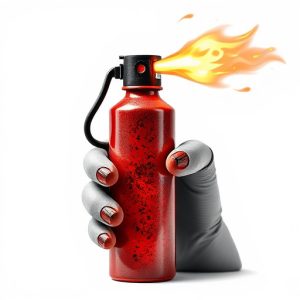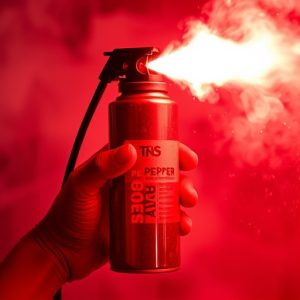Safety and Legalities of Handling Flammable Pepper Spray: A Comprehensive Guide
Pepper spray, a non-lethal self-defense tool containing oleoresin capsicum (OC), effectively incapa…….
Pepper spray, a non-lethal self-defense tool containing oleoresin capsicum (OC), effectively incapacitates attackers by causing intense eye and respiratory irritation. Contrary to some misconceptions, while pepper spray itself is not inherently flammable, the propellant used to deliver it can ignite if exposed to high heat or flames, necessitating safe handling practices. The primary concern with pepper spray isn't its flammability but its effectiveness as a deterrent. To use it safely, one must avoid contact with ignition sources such as fires, stoves, or lit cigarettes and store the spray in cool, dry conditions to prevent accidental combustion. Strict adherence to safety protocols is essential, including keeping a safe distance from flammable materials during discharge and ensuring proper storage. The legal use of pepper spray is subject to federal, state, and local regulations, which are designed to prevent misuse, fires, and harm. Users must be fully informed about these laws to avoid legal consequences and ensure the safe application of pepper spray for self-defense. In summary, while pepper spray can be used for self-defense, it's crucial to handle it with care due to its flammable propellant, follow all safety guidelines, and understand the legal implications associated with its use.
Pepper spray, a widely recognized self-defense tool, incorporates capsaicin derived from chili peppers, which induces intense irritation upon contact with mucous membranes. While its primary function is to incapacitate attackers through intense pain, the safety and legality of this substance are paramount. A pressing concern among users is whether pepper spray is flammable—a critical aspect of handling and storage. This article delves into the composition of pepper sprays, the risks associated with their flammability, the legal frameworks regulating their use, and safe storage practices to mitigate these risks. Understanding these elements is crucial for responsible ownership and usage of this defensive mechanism.
Understanding Pepper Spray and Its Composition
Pepper spray, a widely recognized non-lethal self-defense tool, is a formulation designed to incapacitate an assailant by causing irritation to their eyes and respiratory system. The primary active ingredient in pepper sprays is oleoresin capsicum (OC), derived from natural sources like cayenne peppers. When deployed, the spray releases a cloud of fine particles that contain this irritant. It’s a common misconception whether pepper spray is flammable; while the liquid itself can ignite under certain conditions due to its organic composition, it is not inherently flammable in its typical use form. The risk of fire when using pepper spray is minimal, as the primary function of the spray is for personal defense and not as a flammable substance. It’s important to handle the spray with care, as any combustible substance can ignite if exposed to an open flame or heat source. Understanding that while the components of pepper spray have the potential to burn under extreme conditions, its use in self-defense scenarios does not rely on its combustibility but rather its ability to create an immediate and overwhelming sensation of pain and disorientation, giving the victim a significant advantage in escaping from an attacker. Proper storage and handling of pepper spray ensure it remains effective for personal protection while avoiding any unintended combustion.
The Flammability of Pepper Spray: Safety Precautions and Considerations
Pepper spray, a non-lethal self-defense tool widely used for personal safety, has raised concerns regarding its flammability when in contact with open flames or heat sources. It’s crucial to understand that while pepper spray itself is not inherently flammable, the propellant can ignite under certain conditions. This means that caution must be exercised around sources of ignition, such as fire, stoves, or lit cigarettes, to prevent accidental combustion. Users should avoid handling the spray near these hazards and ensure proper storage away from heat or flames to maintain safety. Law enforcement and individuals alike must adhere to strict safety protocols to prevent any form of misuse that could lead to potentially dangerous situations. When discharging pepper spray, it is important to keep it at arm’s length and avoid aiming it towards any ignitable substances as the spray could contribute to the spread of a fire if direct contact with a flame occurs post-discharge. Adhering to these precautions minimizes the risks associated with the flammability of the propellant, ensuring the safe and effective use of pepper spray for self-defense purposes.
Legal Implications and Regulations Governing the Use of Flammable Self-Defense Products
The use of inflammable self-defense sprays, often including those like pepper spray, carries significant legal implications and is subject to stringent regulations. Pepper spray, a common non-lethal self-defense tool, contains oleoresin capsicum (OC) which, while not inherently flammable, can become hazardous when used in proximity to open flames or ignition sources due to its solvents and propellants. The legal framework surrounding these products is designed to ensure public safety and dictate permissible use, storage, and transportation under law. Manufacturers and users must comply with federal, state, and local regulations that govern the sale, possession, and deployment of such inflammable self-defense products. These regulations aim to prevent misuse, accidents involving fire, and to mitigate any potential harm to individuals and property. It is imperative for consumers to understand the legal boundaries of these products’ use and to adhere strictly to the safety guidelines provided by manufacturers and mandated by law. Failure to comply with these regulations can lead to severe penalties, including fines, imprisonment, or criminal charges. Therefore, when considering the use of pepper spray or similar self-defense sprays, it is crucial to be aware of and adhere to all relevant legal requirements and safety protocols to avoid any unintended legal consequences or dangerous situations.
Best Practices for Storing and Handling Inflammable Spray Safely
When handling inflammable spray, such as pepper spray, adherence to best practices for storage and usage is paramount to ensure safety. Firstly, inflammable sprays like pepper spray should be stored in a cool, dry place, away from direct sunlight and heat sources. This helps prevent the degradation of the spray’s efficacy and reduces the risk of accidental ignition. It’s crucial to keep the spray canisters upright to avoid leaks or the release of contents, which could pose a hazard. Additionally, the spray should be stored in its original packaging, as this is designed to minimize the risks associated with inflammable substances.
Secondly, when in use, inflammable sprays must be handled with care to prevent fire hazards. Users should avoid using or storing the spray near open flames, lit cigarettes, or any other sources of ignition. Regular maintenance checks on the spray equipment are necessary to ensure there are no leaks or damage that could result in a dangerous situation. Proper ventilation is also essential when deploying the spray to prevent the accumulation of vapors, which could potentially ignite. Understanding the properties of inflammable sprays and implementing these safety measures can greatly mitigate the risks associated with their use and storage. It’s important to consult the manufacturer’s guidelines for specific instructions and to follow local regulations regarding the handling of flammable substances. Is pepper spray flammable? While it is, with proper care and handling, users can safely utilize inflammable sprays like pepper spray for self-defense.

